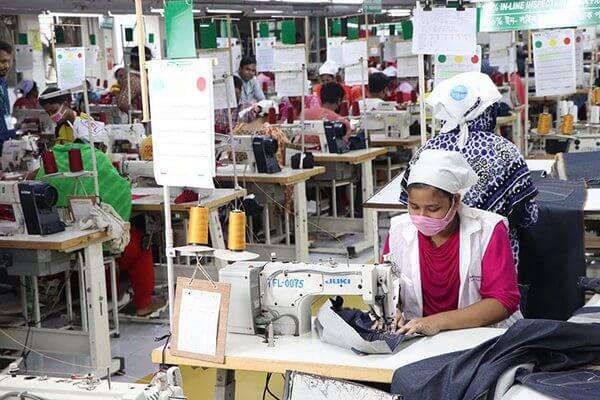Sewing is an operation in the Garment Industry.

Sewing Operation
Sewing is the primary step in creating garment Industry or similar products. Sewing is the process of joining different components of garment industry using the help of needles and thread. Without thread and needle we could also create clothes using different methods of joining such as welding, adhesives, etc. In general, there are two components that are involved in sewing that is. that is. sewing stitches as well as seams. Sewing is the most significant among the various methods of garment Industry joining. The principal reason for sewing is to make seams.
The process of joining “sewing” is characterized in terms of the details regarding the sewing thread, the fabric, as well as the structure of the link (thread/laying of fabric). Sewing is a method of joining by the linking that connects one or more stitching threads with the fabric. The way, location and the number of interlacing or linking points in the fabric define the joint that is created.
Sewing is the art of securing or attaching objects by stitching them with thread and needle. The term is used to describe the procedure employed in factories to produce various kinds of clothing as well as other items made by gluing diverse components over the sequence of a planned process. Sewing is the process of connecting parts and assembling them together to form a garment Industry. The fundamental sewing rules are:
- Stitches,
- Seams,
- A technique of sewing.
Circulate Chart for Stitching Operation within the Garment Industry:
First PPM ( Pre-Production Meeting) completed by all persons concerned
|
Input schedules are collected from the department of planning (through E-mail)
|
Samples are collected from Quality department
|
Layout sheet that was collected at IE department
|
Layout sheet provided to Technical, Mechanic and Supervisors.
|
Collect inputs at Supermarket to Kanban box
|
Thread and other accessories are available from the store
|
M/C arrange, set, or adjust by Mechanic or Supervisor
|
Start of sewing and layout complete
|
First output initial check
|
Process-oriented quality is assured by Quality inspectors on the line through Traffic Light system
|
Quality inspection at the end of the line is conducted by a Table quality inspector
|
QC Pass /QC Fail
|
If QC Pass, the items are received by the Receiver or If QC Fails, then again. Sewing begins and layout is complete
|
Goods are sent via snap button (if necessary)
|
Goods are sent to Final section
Sewing Equipment Types
- Simple machine: top stitch Attaching labels
- Overlock device: Sleeve joining, Side seam joining, Shoulder joining
- Flat lock machine:
- Beds for Cylinders: All kinds of top stitch
- Flat-bed Piping and folding
- Compressor: Sleeve and Bottom hem
- Feed of the arm Taps for back and arm
- Kansai machine: Placket, Waist band
- Button hole machine Button hole and then stitch it
- Attaching button machine to Button: Button attachment
- The Snap Button Machine: Snap button attachment
- The chain stitching machine Waist band
Seam:
A seam is a line that occurs when two fabrics are stitched together in a garment Industry, or other items. A seam is simply the stitching line. Seams are stitched to lines of seams. This is defined as the amount from the seam’s line to the edge of the cut. The typical seam allowance will be (1.5 centimeters) broad.
Property of seam
- Strength of the seam
- Elasticity
- Durability
- Security
- Comfort
- Special properties:
- Waterproof
- Fire proof
Types of seams:
There are eight kinds of seams. They include:
- Class-1: Superimposed seam
- Class 2 Lapped seam
- Class-3 Bound seam
- Class 4 Flat seam
- Class-5: The decorative seam
- Class-6: Edge neatening
- Class-7
- Class-8
Stitch:
Loops or loops made of several threads, when is bound to one another, or by interlacing and interloping or by combining the threads when sewing fabric, each of these units is known as a stitch.
Stitch types:
There are 70 kinds of threads. However, between 18 and 20 types of stitch can be utilized in the textile industry.
All stitches are part of six classes:
- Stitch class 100
- Stitch class 200
- Stitch class 300
- Stitch class 400
- Stitch class 500
- Stitch class 600
Formulae for Thread Consumption to various types of stitches:
- Stitch Type 101 (Single chain stitch with thread)
C = ( 3N + 2T ) + S
- Stitch Type-301 (Single thread lock stitch)
C = ( 2N + 2T ) + S
- Stitch Type-401 (Single needle chain stitch)
C = (4N + 2T) * S
- Stitch Type 504 (Three threads across edge stitch)
C = ( 3N + 4W + 4T ) + S
Here,
C= Thread Consumption
N = Length of Stitch
T = Thickness
S is Stitch Per inch (SPI)
Sewing Issues, Causes, and Remedy:
Table: Sewing Failures The causes, the remedies and how to fix them.
| No: | Sewing Issues | The Reasons | Remedy |
| 1 | Thread breakage in the needle | The winding was misaligned from the Thread package, excessive tension thread of poor quality | Check your overhead guides are not above the stand pin for the cop; choose the strongest thread |
| 2 | Looper thread or Bobbin breakage | A thread that has been badly wound on the Bobbin Adjust | The bobbin winder’s to ensure it is in the right place |
| 3 | Tread fused when machine stops | A thread that has been badly wound on the Bobbin Adjust | the bobbin winder’s to ensure it is in the right place |
| 4 | The stitching is not sewed. | Looper, hook or needle that fails to insert thread loops at the proper timing | Changes the clearance of machines and timings |
| 5 | Imbalance stitching | Correct sewing tension | Look for snarling and adjust thread tension |
| 6 | Variable stitch density | Fabric feed control is not as good | The pressure of feet should be increased. |
| 7 | Seam pucker | Variable different fabric feed Enhance | the mechanism for feeding fabric |




![Have You got One of the Top 6 Shopify Themes? [2022 updated]](https://usdigitaldata.com/wp-content/uploads/2022/03/Shopify.png)
